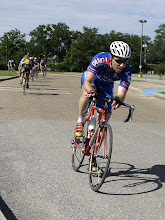It's interesting to observe how individuals sit on their respective saddles. We would have to assume that each rider is sitting on their saddle where it is most comfortable. While there are those times when we forsake comfort for other priorities such as aerodynamics, it should be noted that during the vast majority of our time, we want to be comfortable.
Over the course of the couple years that I've been working with cyclists directly, I've made some interesting observations. Some riders naturally select a position towards the front, others towards the back. I've had clients(of the same general shape and size) that end up with the nose of their saddle 3.5cm behind the bottom bracket and others that end up 8cm behind. This has to be driven in part by saddle design, rider anatomy, flexibility and pedaling technique.
Because of this observation, I think it's
important to note that changing saddles could have a significant impact on rider position. Changing saddles changes everything. Several things have to be thought out completely.
Maybe you are not considering a new saddle specifically but you are getting a new bike(that comes with a different saddle). Your fit and potential the size frame you ride could be determined by how you sit on the saddle. At the very minimum,
seat post design(setback vs. center mount) and stem length are significantly impacted.
Here are the considerations:
1) Padding thickness - If there is a significant amount of padding, you have to consider how much the padding is going to compress. Arbitrary comparison of saddle height between models could leave the rider 1cm lower than a saddle with less padding.
2) Rail height - saddles have different distance between the rails and the actual riding position on the saddle and different distances between the rails and the top. If you just slap a new saddle on the existing
seat post, your eventual saddle height will be different
3) Rail angle - some saddle manufacturers angle the rails so that moving the saddle fore and aft doesn't impact saddle height. It's a novel concept but it can't compensate for the variations in seat tube angle. Depending on where you mount the saddle, it might be higher or lower than the previous saddle based on the angle of the rails.
4) Saddle shape - All saddle manufactures are trying to design comfortable performance saddles. Changing saddle shapes may force you to sit more forward or backward to find the most comfortable position. All of this is in comparison to the nose of the saddle. This has a significant impact on the saddle fore/aft position.
5) Sweet spot - Some saddles have one finite sweet spot while others seem to be
veritable sofas.
Fizik Saddles make a model in each of these categories. The
Aliante has one defined sweet spot. If you move forward, you know it. On the other end of the spectrum you have the
Arione. You can move a couple
centimeters forward or back and you wouldn't be any more or less comfortable. However, your pedaling mechanics could be significantly impacted.
Here are the rules:
Take the time to find a saddle that really works for you.
Pardon the pun, it should be an "intimate relationship!" Comfort is king. Not fashion and definitely not weight. If you find a saddle that is comfortable and stylish and weighs less, great.
Once you find that saddle that works for you, continue to use it until you can't find them anymore(perhaps you should purchase two). If you get a new bike and it comes with an
OEM saddle that doesn't work for you, pitch it in the nearest trash can or Ebay. Don't let a saddle determine your opinion of the bike as a whole. If the saddle sucks, you may think that of the entire bike when it may not be true.
If you change saddles, get your fit tuned again. Changing saddles should not be allowed to change your mechanics!
Expensive saddles aren't always best(for you). Top end saddles are designed for 135lb. European males. Not 170lb. to 200lb. office monkeys(myself noted) who like to get out and do a little riding for fun and self abuse.

